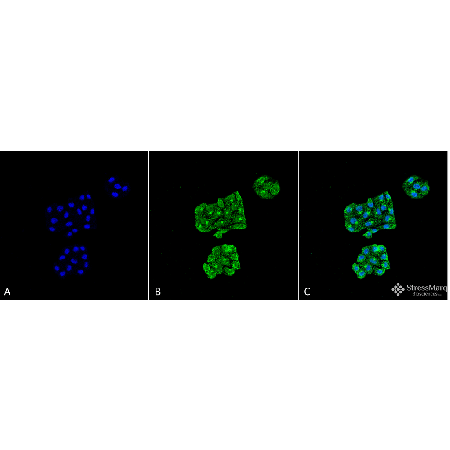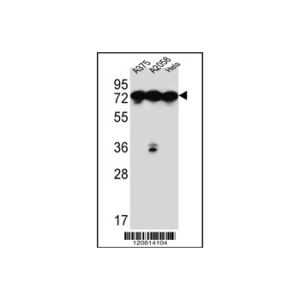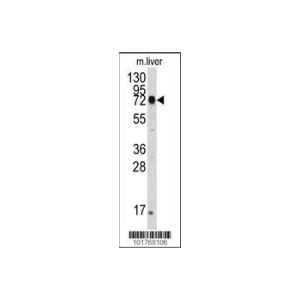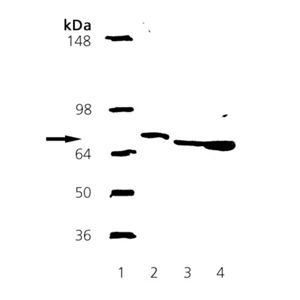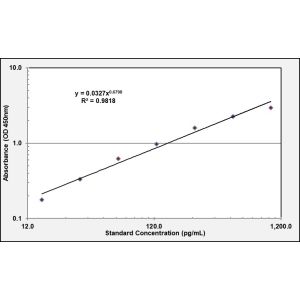GRP78 Antibody
Katalog-Nummer OASE00142
Size : 100ug
Marke : Aviva Systems Biology
| Datasheets/Manuals | Printable datasheet for GRP78 Antibody (OASE00142) |
|---|---|
| COA Datasheet | 0.5 µg/ml of SMC-196 was sufficient for detection of Grp78 in 10 µg of HeLa cell lysate by ECL immunoblot analysis. |
| Predicted Species Reactivity | Bovine|Cryphonectria parasitica|Fungus|Hamster|Human|Monkey|Mouse|Rabbit|Rat|Xenopus|Xenopus laevis |
|---|---|
| Clonality | Monoclonal |
| Clone | 6H4-2G7 |
| Isotype | IgG1 |
| Host | Mouse |
| Conjugation | Unconjugated |
| Application | ELISA,ICC,IF,WB |
| Additional Information | Background Info: Detects a protein with a mass of ~78kDa corresponding to GRP78 |
| :: | Scientific Background: GRP78 is a ubiquitously expressed, 78-kDa glucose- regulated protein, and is commonly referred to as an immunoglobin chain binding protein (BiP). The BiP proteins are categorized as stress response proteins because they play an important role in the prope |
| :: | Certificate of Analysis: 0.5 ug/ml was sufficient for detection of Grp78 in 10ug of HeLa cell lysate by ECL immunoblot analysis. |
| Reconstitution and Storage | -20°C |
| Immunogen | His-tagged human GRP78 |
| Purification | Protein G Purified |
| Concentration | 1 mg/ml |
| Specificity | Detects ~78kDa. |
| Dilution | WB (1:2000), ICC/IF (1:100); optimal dilutions for assays should be determined by the user. |
| Storage Buffer | PBS pH7.4, 50% glycerol, 0.09% sodium azide |
| Description | GRP78 is a ubiquitously expressed, 78-kDa glucose- regulated protein, and is commonly referred to as an immunoglobin chain binding protein (BiP). The BiP proteins are categorized as stress response proteins because they play an important role in the proper folding and assembly of nascent protein and in the scavenging of misfolded proteins in the endoplasmic reticulum lumen. Translation of BiP is directed by an internal ribosomal entry site (IRES) in the 5' non-translated region of the BiP mRNA. BiP IRES activity increases when cells are heat stressed (1). GRP78 is also critical for maintenance of cell homeostasis and the prevention of apoptosis (2). Lou et al. have provided findings that suggest GRP78 is essential for embryonic cell growth and pluripotent cell survival (3). In terms of diseases, GRP78 has been shown to be a reliable biomarker of hypoglycemia, to serve a neuroprotective function in neurons exposed to glutamate and oxidative stress (4), and its protein levels are reduced in the brains of Alzheimer's patients (5). Also, the induction of the GRP78 protein that results in severe glucose and oxygen deprivation could possible lead to drug resistance to anti-tumor drugs (6, 7). |
| Reference | 1. Cho, S. et al. (2007). Mol Cell Biol 27(1): 368-83. 2. Yang, Y. et al. (1998) J Biol Chem 273: 25552-25555. 3. Luo, S. et al (2006) 26 (15): 5688-97. 4. Yu, Z. et al. (1999) Exp Neurol. 15: 302-314. 5. Koomagi, R. et al. (1999) Anticancer Res. 19:4333- 4336. 6. Laquerre, S. et al. (1998) J. Virology 72: 4940-4949. 7. Dong, D. et al. (2005) Cancer Res 65(13): 5785-91. |
|---|---|
| Gene Symbol | Hspa5 |
| Gene Full Name | heat shock protein 5 |
| Alias Symbols | 78 kDa glucose-regulated protein, 78kD, AL022860, AU019543, B, baffl, baffled, binding-immunoglobulin protein, Bip, D2Wsu141, D2Wsu141e, D2Wsu17, D2Wsu17e, endoplasmic reticulum chaperone BiP, glucose regulated protein, 78 kDa, Grp, GRP-78, Grp78, heat shock 70 kDa protein 5, heat shock 70kD protein 5 (glucose-regulated protein, 78kD), heat shock protein 70 family protein 5, heat shock protein family A member 5, Hsce7, Hsce70, HSP70 family protein 5, immunoglobulin heavy chain-binding protein, mB, mBiP, Sez, SEZ-7, Sez7, XAP-1 antigen. |
| NCBI Gene Id | 14828 |
| Protein Name | Endoplasmic reticulum chaperone BiP|endoplasmic reticulum chaperone BiP precursor [Mus musculus] |
| Description of Target | Endoplasmic reticulum chaperone that plays a key role in protein folding and quality control in the endoplasmic reticulum lumen (PubMed:12411443, PubMed:12475965). Involved in the correct folding of proteins and degradation of misfolded proteins via its interaction with DNAJC10/ERdj5, probably to facilitate the release of DNAJC10/ERdj5 from its substrate (PubMed:12411443). Acts as a key repressor of the ERN1/IRE1-mediated unfolded protein response (UPR) (By similarity). In the unstressed endoplasmic reticulum, recruited by DNAJB9/ERdj4 to the luminal region of ERN1/IRE1, leading to disrupt the dimerization of ERN1/IRE1, thereby inactivating ERN1/IRE1 (By similarity). Accumulation of misfolded protein in the endoplasmic reticulum causes release of HSPA5/BiP from ERN1/IRE1, allowing homodimerization and subsequent activation of ERN1/IRE1 (By similarity). |
| Uniprot ID | P20029 |
| Protein Accession # | https://www.ncbi.nlm.nih.gov/protein/NP_001156906.1 |




